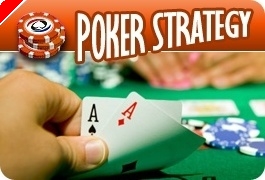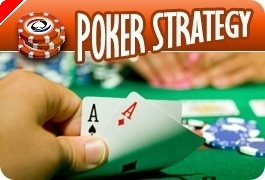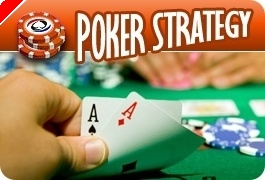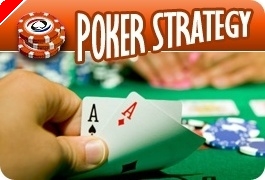Stud Poker Strategy: Questions and Answers, Part #1 -- Bankroll Questions

This week, I'll start a handful of columns where I answer some of the many questions I've received on various aspects of stud poker strategy, both here and at my new webcast show at houseofcardsradio.com.
One listener recently asked me about bankroll. "What should I bring to a $5/10 stud game?" she queried. I avoided the opportunity for sarcasm and answered her straight.
My simple answer is that generally you should bring to a game 60 large bets. So in a $5/10 game that's $600. That gives you enough of a stack not to be constantly worried that you'll be short if you lose a couple of hands. Generally, I recommend that folks buy in for $300 and keep $300 for a rebuy if necessary. If they like, they can put all $600 on the table, as I tend to do. There's nothing scientific to this – it's just a rule of thumb governed by what I feel comfortable with.
There's a more complex answer that is connected to a finer understanding of what they are really asking.
Ask yourself a few questions first.
How much money do you have with which to play poker? What is the size of your entire playing bankroll?
How renewable is this playing bankroll?
Are you looking to play consistently at this level or are you just taking a quick stab at it?
Are you a winning player?
The answers to these questions are essential before you know how much you need.
Let's start with the last question first because it's the easiest. If you are a losing player, it doesn't matter how much you bring to the table because you will eventually go through it. When you do, you can just not play until you get your next fix of money and then burn through that. The only question is how long you'd like to play for. Figure out how much you lose an hour, and plan on having that long to play until you're broke and have to wait to reload when you can. Simple.
If you're a winning player and want to know what you need to play, then you're really asking how large a bankroll you'll need to absorb the potential losses you might suffer due to the vagaries of chance.
This too depends on how good a player you are. If you are ten times as good as the players you're playing against and can win, on average, ten big bets an hour, and your variance is very small, then you'd need the minimum buy-in – ten times the large bet in most card rooms. Sit down, play your best game, destroy the opposition, and never look back. I've never seen anyone close to this good, but if you are, hey, don't worry about having any more money than absolutely necessary.
For the mere mortals out there, who are winning players but only to the tune of one or two big bets an hour, the answer is more complicated. You will have to worry about going broke during a session if you aren't deep enough. You also have to be concerned about burning through your entire poker-playing bankroll.
For you players I recommend that you have 200 big bets lined up to take a consistent stab at the game – to give it your full attention. Standard deviation being what it is, you may need $2,000 to ride the waves in a $5/10 game. If the game you're in is especially tumultuous, you may want 300 big bets – or $3,000 for a $5/10 game.
But there's another consideration. How hard is it to replace your playing bankroll? If you make your living as a poker player it's very tough – because your living expenses must come out of your poker-playing money as well. If you burn through your bankroll you're not just short of cash for the game, you're going into debt to pay your bills – adding interest payments to your monthly nut. Dig yourself deep enough and there may be no way of shoveling your way out.
For those players I recommend a more conservative, geometric progression of how much money they need to play in a game. If they can replenish their $5/10 bankroll easily, then 200 big bets – or $2,000 is enough. But as the stakes go up, their ability to replenish surely lessens. So $4,000 wouldn't be enough for a $10/20 game. It would have to be 400 big bets or $8,000. At $20/40 they'd need $32,000 (800 big bets). Similarly, at $40/80 they'd need 800 big bets – $64,000. And at a $100/200 game they'd need a bankroll of about 2,000 big bets – or $400,000.
Even these amounts may be on the low side based on your individual ability to replenish your funds.
But here's some good news for regular, medium-pocketed poker players. If all you're interested in is taking a quick stab at a game – to test the waters so to speak — you don't need all this money. You can make do with less – a whole lot less.
I recommend that you have 25 times the big bet just to take a shot at a bigger game – one rank up from where you are. By "taking a shot," I mean playing to get your feet wet, experience the bigger game, and try to make enough to play at that level regularly.
To do this you'd first alter your strategy to decrease your variance – playing more conservatively, being somewhat less aggressive for the most part and playing fewer drawing hands. You'll win less per hour than playing your optimal strategy. But you're deliberately altering your game to make the higher stakes version more affordable to you.
And you'd be willing to drop back down to the game you are consistently beating after suffering a few losing hands in a row.
So, for example, if you're typically a $10/20 player but have noticed that the $20/40 games seem looser and easier to beat than your typical rock fest, you might sit down at $20/40 with $1,000. That will give you enough play to withstand a few losses before you are worried that your bankroll is crippled. And if you do go to the river three times and lose – costing yourself $600 or so in the process, you can always drop back down to the $10/20 game, play your typically profitable game, and win back the money in 15 or 20 hours of play.
This is an option only where there are multiple games at multiple levels – as there are on the Internet and in large poker rooms. It's tougher, if not impossible to do this in places where there's one very big game and other smaller games. In those places, where there might be a $1-5 stud game and then a $20/40 or $30/60 game on the weekends perhaps, you have to be able to accumulate much more than 20 big bets – or be willing to wait a lot longer before you can move back up into it if you lose your buy-in.





